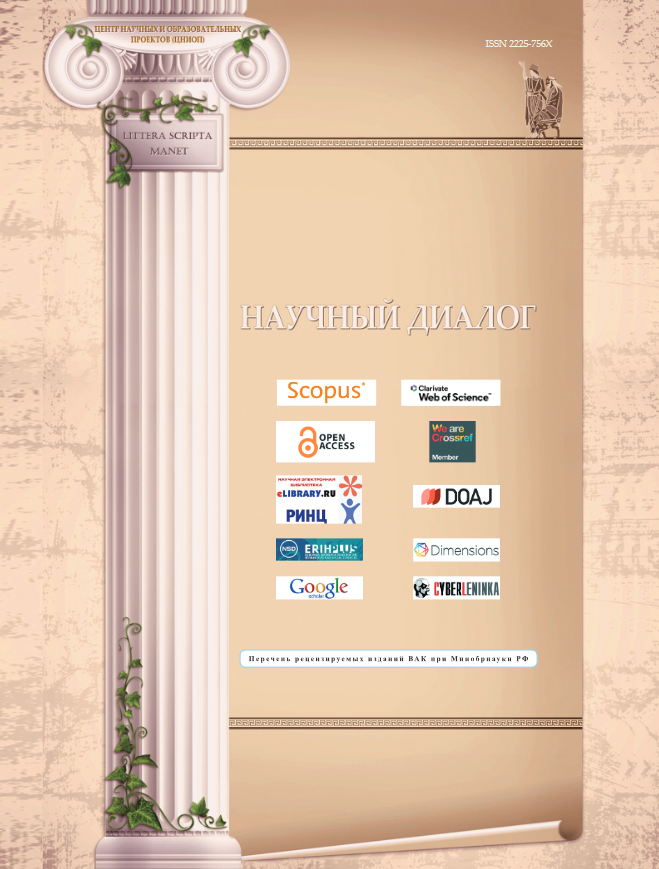Nauchnyi Dialog
Nauchnyi dialog (Scientific Dialogue), registration certificate PI No. FS 77-86214 issued 27.10.2023 by Roskomnadzor, is an open-access peer-reviewed scientific journal. Nauchnyi dialog (Scientific Dialogue) publishes research articles presenting novel concepts and significant achievements in the fields philology and history.
Theme: Russia and the world in dialogue
- Russian world: language, literature, folklore, history
- History of the abroad through the eyes of russian researchers
- Russian world surrounded by other cultures: comparative studies
- Media communications and journalism: a world without borders
- Theory and methodology of language and literature research as a space for dialogue between different scientific traditions
Mission of Nauchnyi Dialog — organizing a dialogue between national research traditions in the humanitarian branches of science - historical and philological.
Tasks:
1) accumulation of knowledge about Russian culture through studies of language, literature and Russian history as the main markers of identity surrounded by other identities;
2) exchange of interpretations of a foreign cultural text: Russian literature and history as interpreted by foreign colleagues - and foreign literary and historical discourse as interpreted by Russian researchers;
3) presentation of the observations of researchers from different countries of the media development as a factor in globalization;
4) inviting researchers from different countries to present and discuss theories, approaches, methods, techniques for analyzing language, text, discourse, since due to a long period of closed development of national scientific traditions and schools, discrepancies have accumulated in the choice of research problems, interpretations of key terms, methodological preferences.
Language of publications: Russian. Each article is provided with metadata in English.
Published since 2012.
The Journal accepts for consideration (1) review articles containing theoretical and statistical generalizations and (2) original research articles presenting the results of empirical investigations.
All submitted manuscripts undergo mandatory peer review (reviews provided by authors are not accepted).
Submissions are reviewed within the average period of 3–10 months.
Current Issue
Vol 14, No 8 (2025)
LINGUISTICS
Illocutionary Force of Adverbial Clauses: Evidence from German
Abstract
 9-39
9-39


A Psycholinguistic Study of Assimilation Mechanism of Value Concept “Itegel” (“Faith”) Based on an Associative Database (Material from Sakha Language)
Abstract
 40-63
40-63


Northern Russian Isoglosses in Middle Volga Region
Abstract
 64-78
64-78


Karelian Language in Periodical Press: Dynamics of Functioning as a Reflection of Shifts in Language Ideology and Policy in 20th–21st Centuries
Abstract
 79-100
79-100


Formulaicity of German Controlled Language as a Translation Challenge for Neural Machine Translation
Abstract
 101-120
101-120


Terms as a Result of Various Forms of Borrowing (Language of Digital Society)
Abstract
 121-140
121-140


Word Family with a Common Base чомуо [chomu] ‘to be big’ in Language of Forest Yukaghirs
Abstract
 141-160
141-160


Academician Bayer on Rus’ and Russia: Figurative Language in Scholarly and Poetic Texts
Abstract
 161-180
161-180


Colorative Markers of Modernity in Contemporary Cultural Conflicts
Abstract
 181-204
181-204


Nominative and Accusative Cases of Russian Nouns in Contexts of Adverbialization Combined with Modality, Pronominalization, Particulation, and Interjection
Abstract
 205-229
205-229


MEDIA COMMUNICATIONS AND JOURNALISM
Generative Neural Networks in Regional Mass Media: Usage Proficiency and Ethical Attitudes of Journalists and Students in Nizhny Novgorod
Abstract
 231-254
231-254


A Two-Factor Model for Perception of Graffiti by Metropolis Dwellers
Abstract
 255-276
255-276


LITERARY STUDIES. FOLKLORE
Receptive Strategy of Martin Amis's Novel “The Zone of Interest”
Abstract
 278-295
278-295


Authentic Intonation of Lermontov’s Poem “Journalist, Reader, and Writer” (1840) as a Key to Understanding Author’s Intent
Abstract
 296-316
296-316


Reception of Mikhail Sholokhov’s “The Fate of a Man” in Chinese Literary Criticism
Abstract
 317-343
317-343


Schiller versus Bürger: An Eighteenth-Century Debate on Nature of Popular Art
Abstract
 344-363
344-363


Northern Myth in Works of Finnish Prose Writers of Second Half of 19th Century (Fairy Tales of Zacharias Topelius)
Abstract
 364-379
364-379


HISTORY
Historical Trends in Development of Urban Planning in Krasnodar in 1921—1941
Abstract
 381-396
381-396


Maritime Transportation of Russian Pilgrims to Palestine in Late 19th Century
Abstract
 397-420
397-420


Legal and Regulatory Framework for Cybersecurity in Arab Gulf Monarchies: Stages and Features of Development
Abstract
 421-441
421-441


Role of Rail Transport in Economy of Transcaspian Region: A Case Study of Murghab Sovereign’s Estate (1896–1912)
Abstract
 442-459
442-459


Activities of Grassroots Party Cells in North Ossetia and Organization of Ideological Control Over Them in 1920s
Abstract
 460-480
460-480


Decembrists Exonerated by Investigative Commission: Lieutenant Colonel I. A. Arsenyev
Abstract
 481-503
481-503


Peasant Sentiment during First World War: A Study of Lèse-majesté Cases in Imperial Russia
Abstract
 504-528
504-528


Development of Felted Footwear Craft in Tambov Province During Transition from Late Imperial to Soviet System
Abstract
 529-548
529-548


Abolition of Courts of Conscience in Russian Empire: A Study of Causality
Abstract
 549-567
549-567


Textile Industry of North Caucasus Region (1927-1934): Conditions for Development and Production Challenges
Abstract
 568-588
568-588











